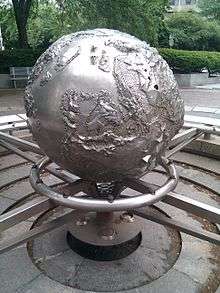Joe Davis (artist)


Joe Davis (born 1951) is a research affiliate in the Department of Biology at MIT, and in the George Church Laboratory at Harvard Medical School. His research and art includes work in the fields of molecular biology, bioinformatics, "space art", and sculpture, using media including centrifuges, radios, prosthetics, magnetic fields, and genetic material. Davis' teaching positions have been at MIT and the Rhode Island School of Design (RISD).
Davis' works include the sculpture Earth Sphere, a landmark fog fountain at Kendall Square, Cambridge, Massachusetts, near the MIT campus;[1] RuBisCo Stars, a transmission of a message to nearby stars from the Arecibo Observatory radiotelescope in Puerto Rico, carried out in November 2009;[2][3] New Age Ruby Falls, a project to create an artificial aurora using a 100,000 watt electron beam fired into the magnetosphere from a NASA space shuttle (which has not yet been carried out);[4] and Microvenus, a piece of symbolic art involving engineering the genetic code of a microbe.[5][6][7]
Significance
Davis' work has been featured in scientific journals, art magazines, and mainstream media[8]—including Scientific American,[9] Nature magazine, and several books.[10][11] Additionally, Davis has contributed to projects associated with the DIYbio movement[12] . He is frequently invited to speak at universities, labs, and art institutes.[13] Davis' life was further detailed in a feature-length documentary entitled Heaven and Earth and Joe Davis.[14][15][16] Davis has had many media appearances including being mocked twice on the Colbert Report. A segment was also produced on Nova.[17] In 2001, the Washington Post termed Davis the "éminence grise of the 'bioart' movement", saying further, "Davis eschews the art versus science argument, insisting that he speaks both languages and could not possibly tear the two disciplines apart in his own mind".[18]
Davis' work has further significance in documenting and critiquing early attempts at steganographic encoding of culturally important messages and images for future generations or extraterrestrial cultures.[6] Davis has stated that he does not wish to create "green rabbits or purple dogs", but rather to manipulate the reams of silent, "junk DNA" that comprise more than 90% of an organism's genetic code.[19]
Other works
- Audio Microscope - a microscope that translates light information into sound allowing you to "hear" living cells, each with its own "acoustic signature"
- Experiments with how E. coli respond to jazz, and other sounds, with Adam Zaretsky[4]
- Putting a map of the Milky Way into the ear of a transgenic mouse
- "Primordial" clocks - a project surrounding a theory that life spontaneously self-assembled
- Plans for channeling lightning bolts into a pulsed laser of almost unparalleled energy and into towering sculptures that would change the bolts' color and emit incredibly loud tones[4]
- Poetica Vaginal - a signal sent to several nearby star systems fashioned from the sound of vaginal contractions[20]
- Malus ecclesia - encoding the English Wikipedia into the apple tree genome to create a living, literal tree of knowledge[21]
References
- ↑ Joan Brigham (Summer 1990). "Steam Heat" (PDF). Places. 6: 42–49.
- ↑ Joe Davis (18 Nov 2009). Centauri Dreams blog ""Rubisco Stars" transmission to extraterrestrials" Check
|url=value (help). - ↑ "ET: Check your voicemail (from MIT News)". 24 Nov 2009.
- 1 2 3 "The Brilliantly Weird World of MIT's 'Mad' Scientist". The Daily Galaxy. Oct 2008.
- ↑ "Viewing Space".
- 1 2 Joe Davis. "Artistic Molecules, Microbes, and the "Listening Microscope". "New Media" is Very Old".
- ↑ Joe Davis (1996). "Microvenus". Art Journal. 55 (1): 70–74. JSTOR 777811. doi:10.2307/777811.
- ↑ "Bioart: An Introduction". 2015.
- ↑ Gibbs, W. Wayt (April 2001). "Art as a form of life (profile of Joe Davis)" (full text copy: reference verified at ). Scientific American.
- ↑ Mitchell, Robert (2010). Bioart and the Vitality of Media. Seattle: University of Washington Press.
- ↑ Reichle, Ingeborg (2009). Art in the Age of Technoscience. Genetic Engineering, Robotics, and Artificial Life in Contemporary Art. Wien & New York: Springer.
- ↑ Ali K. Yetisen; Joe Davis; Ahmet F. Coskun; George M. Church; Seok Hyun Yun (2015). "Bioart" (PDF). Trends in Biotechnology. 33: 724–734. doi:10.1016/j.tibtech.2015.09.011.
- ↑ "Cornell Council for the Arts Biennial, 2013".
- ↑ "Heaven and Earth and Joe Davis. The documentary.".
- ↑ "Heaven and Earth and Joe Davis. Video Excerpt".
- ↑ "Director Peter Sasowsky".
- ↑ "Scientist? Artist. Pirate! Who Is Joe Davis?, Nova PBS".
- ↑ Pamela Ferdinand (Dec 2001). "Art and Science: At MIT, Science Gives New Life to Art". Washington Post.
- ↑ Emily Voigt (Fall–Winter 2009). "The Art is Alive!". Isotope: A Journal of Literary Science and Nature Writing.
- ↑ Marshall, Michael. "Earth calling: A short history of radio messages to ET". NewScientist. Reed Business Information. Retrieved 1 September 2013.
- ↑ House, Patrick (2014-05-13). "Object of Interest: The Twice-Forbidden Fruit". The New Yorker. Retrieved 2014-10-10.
External links
- Joe Davis: Genetics and Culture
- Genesthetics - Joe Davis Bioart Archive
- 13-Jun-2001 MIT Art News
- Interview to Yiannis Melanitis